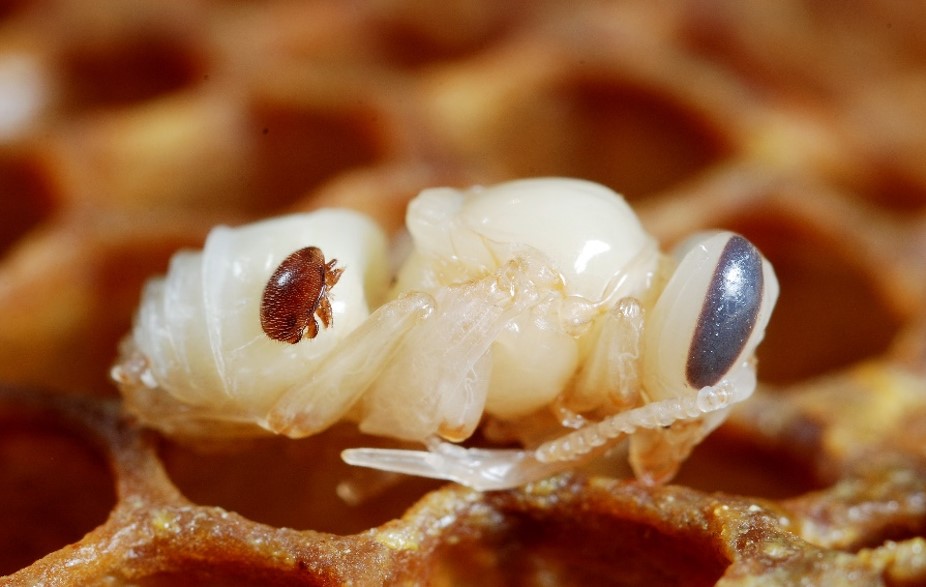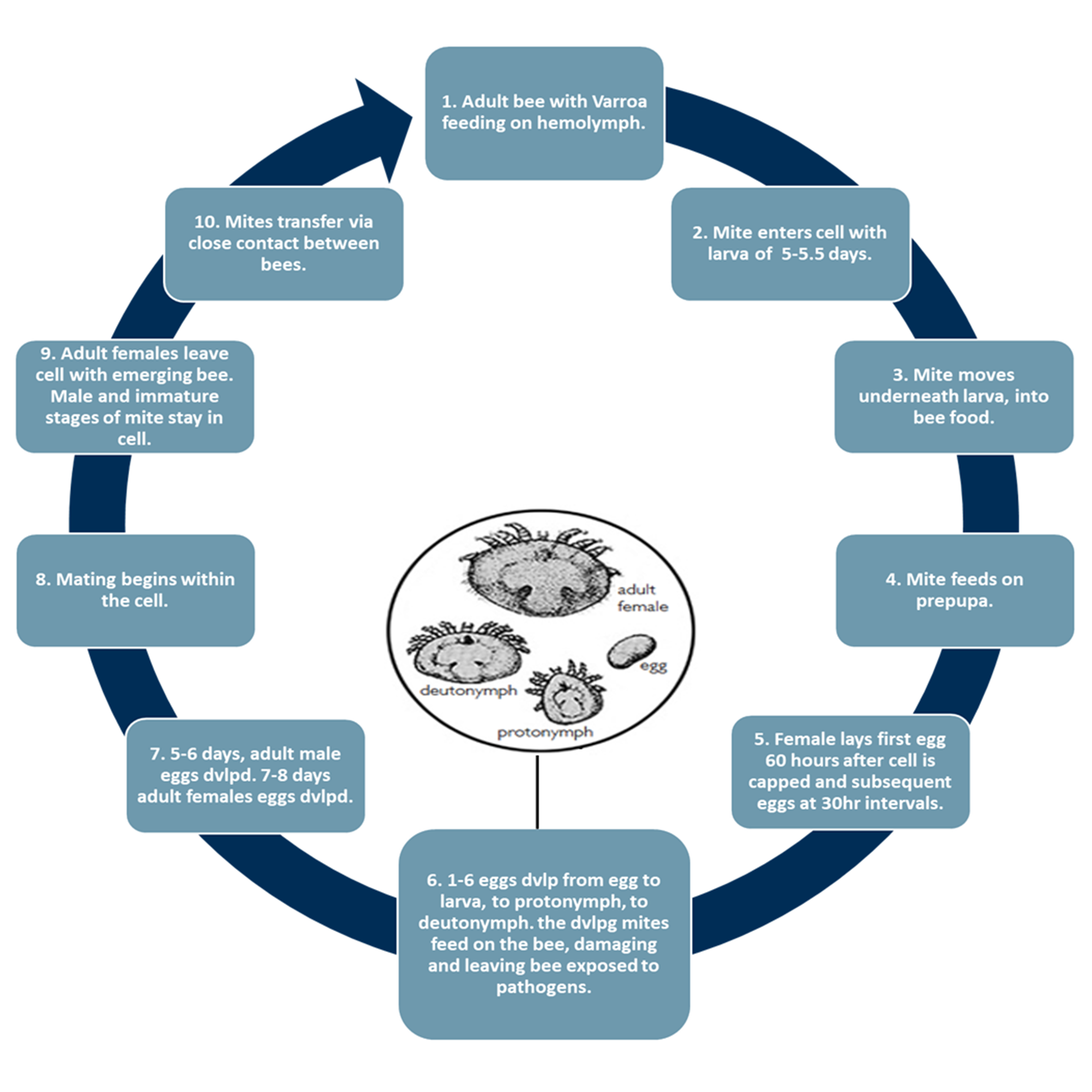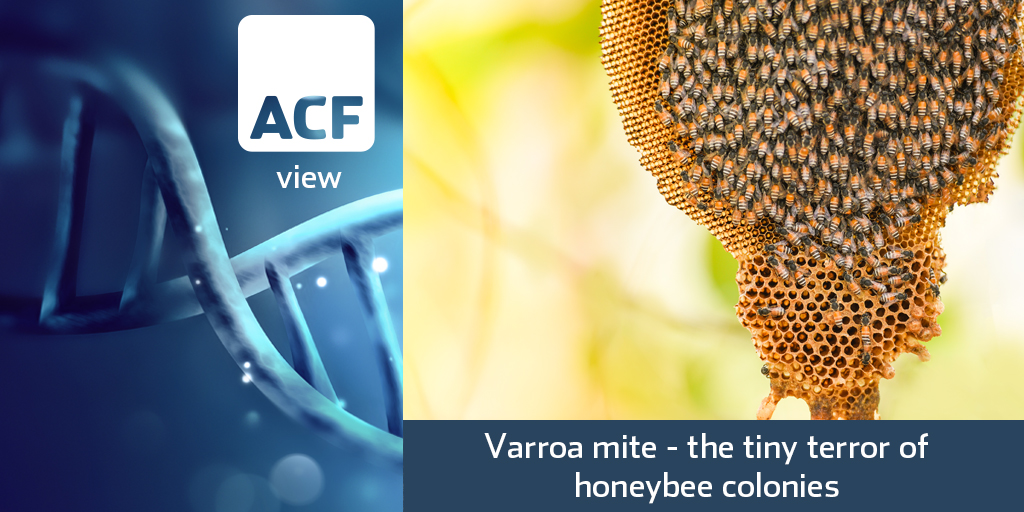Varroa mite – the tiny terror of honeybee colonies
In February 2023, ACF Equity Research published a blog on the very first honeybee vaccine against American Foulbrood (AFB) that was approved by the FDA. However, AFB is not the only significant threat to honeybees – the well-known Varroa mite (exhibit 1) infestations are just as deadly to honeybee colonies, and for which, there is a new and interesting anti Varroa option under development using an RNA syrup. There is other good news too.
AFB compared to Varroa – a recap
American Foulbrood is a highly infectious and deadly disease caused by the bacterium Paenibacillus larvae. The bacteria infect the brood (the larvae and pupae), consuming the larvae’s resources. Infected larvae typically die after the cell has been capped (i.e. sealed with a thin film of beeswax) and the disease spreads when bees consume AFB spores while cleaning these cells. AFB spores are highly resistant and can remain viable for many years, waiting to be ingested by bee larvae.
In contrast, Varroa mites (Varroa destructor) are external parasites that feed on the hemolymph (bee equivalent of blood) of adult and immature bees, weakening their immune systems and making them more susceptible to other diseases and viruses like the Deformed Wing Virus (DWV is a viral pathogen in honeybees – apis mellifera that damages flight ability). The mites also reproduce within the brood (eggs, larvae & pupae) cells, leading to a rapid increase in the Varroa population in the hive.
Both American Foulbrood (AFB) and Varroa mite infestations can occur independently of each other in a honeybee colony and neither necessarily precedes the other. However, the sequence or timing of infestation varies based on local bee population health, hive management practices and environmental conditions. In both cases, if one of either AFB or Varroa is present it can make the colony more susceptible to the other.
Exhibit 1 – Varroa mite/destructor on a bee nymph
 Sources: Gilles San Martin from Namur, Belgium, CC BY-SA 2.0 via Wikimedia Commons
Sources: Gilles San Martin from Namur, Belgium, CC BY-SA 2.0 via Wikimedia Commons
Varroa mite – the tiny terror
Beekeeping/apiculture is a practice that dates back to ancient Greek and Roman civilization – a blend of art and science. In recent years, apiarists (beekeepers) worldwide have been challenged by a the nearly invisible Varroa mite enemy.
The Varroa destructor is a tiny ectoparasite (a parasite that lives on the exterior of its host, e.g. fleas, ticks, lice), about the size of a pinhead. The Varroa destructor, more commonly known as the Varroa mite, has emerged as one of the leading causes of honeybee colony deaths.
Fighting and potentially eradicating the Varroa mite is necessary because:
- It is a threat to bee health and survival: Varroa mites feed on the hemolymph (a fluid equivalent to blood) of both adult bees and developing brood ultimately leading to the death of entire colonies.
- It is a vector for diseases: Varroa mites are vectors for viral diseases, e.g. Deformed Wing Virus (DWV).
- It has a global impact on apiculture: Since its spread from Asia in the mid-20th century, the Varroa mite has become a global problem and is now found in almost all regions (Europe, N. & S. America, Asia, Africa, Australia and New Zealand).
- It carries economic and agricultural consequences: Honeybees are critical pollinators for many crops and local bee population decline due to Varroa mites leads to decreased crop yields, economic losses and a threat to global food security. (Total pollinators, including honeybees, contribution to global annual food production to the economy is ~$235-577bn – NCSL Apr 2023.)
- It is a threat to biodiversity: Honeybees are essential to maintaining biodiversity by assisting in the pollination of a wide range of plants, contributing to varied and healthy ecosystems.
The Varroa lifecycle begins (exhibit 2) when a female mite invades a brood cell within the hive just before the cell is sealed. Once inside, the mite begins reproducing.
The Varroa mite’s impact on bee colonies’ health goes beyond the direct physical harm it causes by feeding on bees. The mites act as vectors for various bee viruses, over time the weakened bee immune systems reduce the overall health of the colony and lead to Colony Collapse Disorder (CCD).
During CCD most worker bees abandon the hive, leaving the queen and a few nurse bees behind.
Exhibit 2 – Varroa mite infection cycle
 Sources: ACF Equity Research Graphics; B. Alexander. Notes: Prepupa = mature larvae
Sources: ACF Equity Research Graphics; B. Alexander. Notes: Prepupa = mature larvae
Colony Collapse Disorder (CCD) on the rise
Colony Collapse Disorder (CCD) has been widely reported since the early 2000s and has become a significant concern for beekeepers and agriculturists due to the significant role honeybees play in pollination. The Varroa mite is considered to be a major stressor and contributing factor to CCD.
One of the characteristics of CCD is the rapid loss of adult worker bees. The combination of physical weakening, viral diseases and potential secondary infections facilitated by Varroa mites can quickly destroy worker bee populations. In addition, since mites preferentially infest the drone brood (male bees), a high mite infestation can also lead to a skewed worker-drone ratio.
More research is needed to understand the complexity of CCD and the role of Varroa mites, but it is clear that controlling mite infestation is a critical step in maintaining bee colony health. Strategies adopted for mite control range from chemical treatments like miticides to non-chemical methods such as drone brood removal, heat treatments and more recently RNA interferences.
Battling the Varroa mite with RNA syrup
One significant breakthrough in beekeepers’ and scientists’ strategies is the development of Varroa Sensitive Hygiene (VSH) bees. VSH is a behavioural trait of honeybees (apis mellifera) that allows them to resist infestation by the Varroa mite. These bees can detect the presence of Varroa mites in brood cells and remove the infested pupae, therefore interrupting the mite’s reproductive cycle.
In recent years there have been significant strides made in the field of RNA interference (RNAi) for pest control, including the Varroa mites. RNAi is a naturally occurring process where small RNA molecules inhibit gene expression by causing the destruction of specific messenger RNA (mRNA) molecules. This has the potential to control pests by targeting critical genes necessary for their survival.
GreenLight Bioscience (NasdaqGM:GRNA, MCAP~$43m) is developing an RNA-based syrup to attack Varroa mites. The RNA acts like an ‘off switch’ stopping the mites from laying offspring that attach to the bees.
The technology involves creating double-stranded RNA (dsRNA) that matches the sequence of a critical gene in the Varroa mite. When the mites ingest this dsRNA (through an RNA-based syrup fed to the bees), the aim is that it triggers the RNAi process within the mite, leading to the suppression or elimination of the targeted gene and ultimately the mite’s death.
While this technology is incredibly promising, it is also very complex.
- The appropriate genes must be identified, which requires extensive genetic and functional research, though AI, increasingly, will be able to help with this.
- There are practical challenges such as how to get the mites to ingest the dsRNA. Honeybees feed on nectar, which becomes honey and pollen, which is stored as bee bread. They also share food among themselves through a process called trophallaxis. Some studies have shown that dsRNA can be stable in honey and bee bread and can be shared among bees, suggesting possible ways to get the dsRNA into the mites.
- There are concerns related to off-target effects and the impact on non-target species, which would need to be thoroughly assessed before widespread implementation. It is also important to consider potential resistance developing in the mites over time.
Beehive numbers worldwide remain resilient – thanks to human intervention
Although the honeybee colonies are facing significant challenges, the number of beehives worldwide continues to increase (exhibit 3).
Exhibit 3 – Global number of beehives 2010-2021A
 Sources: ACF Equity Research Graphics; FAO.
Sources: ACF Equity Research Graphics; FAO.
This is down to several factors:
Increased public awareness of the crucial role bees play in ecosystems and agriculture as pollinators. This has led to increased interest in apiculture, both at the amateur and commercial level.
Urban and backyard beekeeping are resurging in many cities around the world and interest is increasing in local, sustainable food production. Regulatory changes have made it easier for individuals to keep beehives in urban and suburban environments.
Commercial pollination services (production of pollinator-dependent crops) demand has risen in agriculture, particularly in regions with extensive mono-crop farming, e.g. almond farms in California, USA.
Mitigation strategies are being developed by beekeepers and scientists to manage pests and diseases. These include the use of Varroa-resistant bee strains, integrated pest management strategies and treatments against diseases (e.g. AFB vaccine).
Government and non-government initiatives globally have launched to support beekeeping, provide education and resources and safeguard native pollinators. Below are a few examples:
- Pollinator Health Task Force (US) – Launched by the US federal government in 2014 to promote the health of honey bees and other pollinators. The Task Force developed a National Pollinator Health Strategy, which includes a research action plan, public education and public-private partnerships.
- BeeConnected (Australia, UK, Canada) – Initiative from CropLife Australia, the British Crop Production Council. and CropLife Canada. BeeConnected is an app that connects registered beekeepers, farmers and spray contractors to share information and protect local bee populations from accidental pesticide exposure.
- Bee Health Platform (EU) – Established by the European Commission to share information about bee health, including research, best practices, and legislation. The EU has also restricted the use of certain pesticides (neonicotinoids) that are harmful to bees.
- Operation Pollinator (Global) – Initiative by Syngenta, a global agribusiness company. Operation Pollinator aims to boost the number of pollinating insects on commercial farms by creating specific habitats, rich in native wildflowers.




















